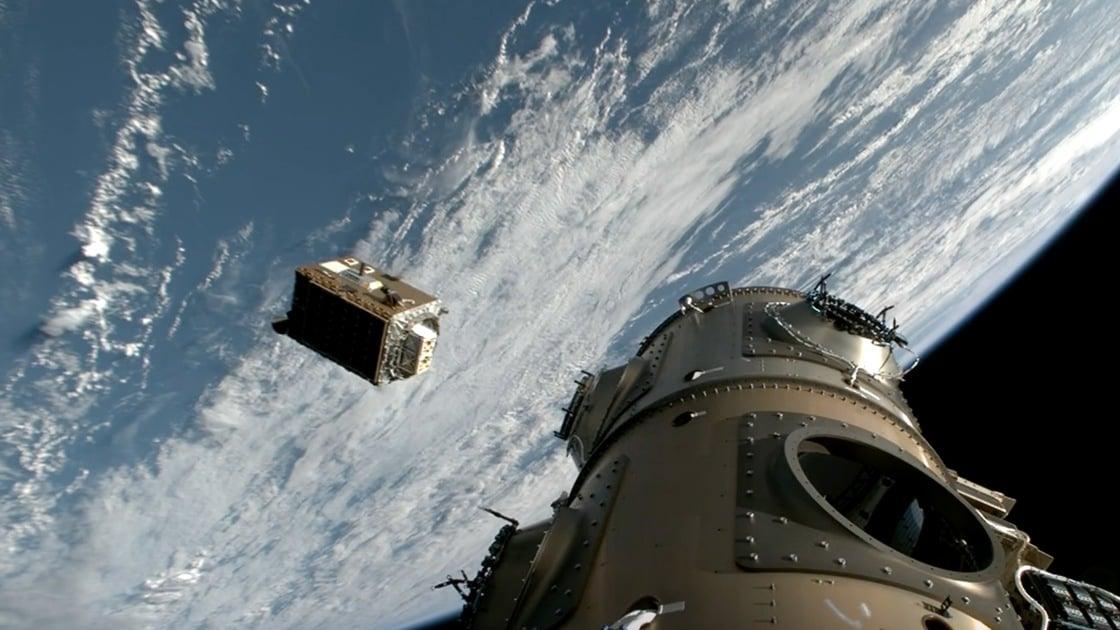German Researchers Achieve First Autonomous AI-Controlled Satellite Reorientation in Space
2 Sources
2 Sources
[1]
Orbiting satellite uses AI to reorient itself in 'major step towards full autonomy in space'
Controlling the orientation of satellites in orbit is tricky business, but autonomous AI might make things a whole lot simpler. (Image credit: Yuichiro Chino/Getty Images) For the first time, researchers have controlled the orientation of a satellite in space using an autonomous AI, a major feat that could greatly improve the safety and effectiveness of satellites in space. While satellites in orbit are carried around Earth by the pull of the planet's gravity, the momentum of their initial deployment and controlled propulsion, it is also necessary to adjust which way a satellite is facing. This allows instruments to point in the right direction, helps manage the thermal effects of solar radiation, and makes repositioning the satellite possible when needed. To do this, you must adjust a satellite's attitude, the technical name for an object's orientation relative to its inertial frame of reference. Essentially, we're talking about rotating the satellite "horizontally" while it is moving. Normally, these maneuvers are handled by human operators directing the satellite remotely or by programmed software routines. Both methods take considerable time and expense, and they don't account for every possible circumstance, especially ones that engineers fail to predict ahead of time. Fortunately, researchers at Julius-Maximilians-Universität Würzburg (JMU) in Germany have developed -- and demonstrated -- an AI system that can change the attitude of an orbiting satellite without any human input, showing that autonomous control of satellites in a real-space environment is possible. The project, called the In-Orbit Demonstrator for Learning Attitude Control (LeLaR), uses a type of machine-learning process called deep reinforcement learning to "teach" the satellite's flight control software how and when to adjust its own attitude when required. Rather than spending months or years programming a satellite's behavior directly, with this method, engineers can train the satellite to effectively program itself to do the same thing, a much faster and cheaper process. The researchers developed the AI model in a lab at JMU, using a "high-fidelity" simulator to train the model before uploading it to the flight controller of the InnoCube nanosatellite, currently in low Earth orbit. The initial test, carried out during a satellite pass on Oct. 30, involved setting a target attitude for the satellite and letting the controller adjust itself to match. Using mechanical reaction wheels controlled by the new system, the satellite adjusted itself to the desired orientation on its own, a feat the JMU team repeated on several subsequent passes. "This successful test marks a major step forward in the development of future satellite control systems," Tom Baumann, a JMU research assistant in aerospace information technology and LeLar team member, said in a JMU statement. "It shows that AI can not only perform in simulation but also execute precise, autonomous maneuvers under real conditions." While the JMU team's demonstration might be the first time a satellite controlled its own orientation in orbit, it isn't the first use of AI systems to improve and automate important satellite functions. NASA's Jet Propulsion Laboratory successfully used an automated AI system to perform "dynamic targeting" of a satellite's ground-facing camera to avoid cloud cover, and after successful lab tests, the U.S. Naval Research Laboratory is working to deploy its Autosat system, which will let a satellite calibrate its own signal as well as send and receive data autonomously. Researchers at the University of California, Davis and Proteus Space are also preparing to launch a satellite in the coming months that can autonomously monitor the health of its own systems, freeing up engineers for other tasks None of those systems actually controlled the motion of the actual satellite, however, and this new approach to satellite flight control could pave the way for simpler and more efficient satellite development, reducing costs and speeding up deployments. "It's a major step towards full autonomy in space," said Professor Sergio Montenegro, a LeLaR team member at JMU. "We are at the beginning of a new class of satellite control systems: intelligent, adaptive and self-learning."
[2]
German Team Uses Autonomous AI to Steer CubeSat in Space
Breakthrough points toward fully autonomous, low-cost future missions. Scientists have been able to control the orientation of a satellite in orbit autonomously, the first time, with an autonomous AI controller. This demonstration, conducted on a 3U CubeSat named InnoCube demonstrates AI with the ability to autonomously point the satellite (its pointing direction) without human operator intervention. The test, which was conducted by a group of scientists at the JMU Würzburg of Germany, is regarded as a step towards autonomous spacecraft in totality. According to researchers, this method may make it easier to create satellite and reduce the cost of missions. AI-driven Satellite Reorientation According to media reports, late in 2025, JMU researchers experimented with an AI controller on a 3U CubeSat. In one of the Oct. 30 passes, the AI agent oriented the CubeSat in its initial orientation to a desired attitude it with its reaction wheels. This was repeated multiple times, and the CubeSat was oriented. The AI controller was trained in a simulator by deep reinforcement learning and uploaded onboard an aircraft to fly. The researchers of JMU reported that the test demonstrated that a neural-network AI could operate a satellite, and the finding was a significant advancement in space missions. Broader Trends in Autonomous Spacecraft Other teams are exploring similar AI-driven systems. NASA's Jet Propulsion Laboratory has demonstrated a "Dynamic Targeting" algorithm that lets a satellite autonomously avoid clouds and select clear targets. The U.S. Naval Research Lab is developing a fully autonomous satellite, "Autosat," that can task its sensors and handle communications without ground control. Engineers at UC Davis are launching a CubeSat with an onboard AI "digital twin" to continuously monitor and predict the satellite's battery health.
Share
Share
Copy Link
Scientists at Julius-Maximilians-Universität Würzburg successfully demonstrated the first autonomous AI system to control satellite orientation in orbit, marking a significant milestone toward fully autonomous spacecraft operations.

Historic Achievement in Space AI
Researchers at Julius-Maximilians-Universität Würzburg (JMU) in Germany have achieved a groundbreaking milestone in space technology by successfully demonstrating the first autonomous AI system capable of controlling satellite orientation in orbit
1
. The project, called the In-Orbit Demonstrator for Learning Attitude Control (LeLaR), represents a major advancement toward fully autonomous spacecraft operations.Technical Implementation and Testing
The breakthrough was accomplished using a 3U CubeSat named InnoCube, currently operating in low Earth orbit. The AI system employs deep reinforcement learning to teach the satellite's flight control software how and when to adjust its attitude—the technical term for an object's orientation relative to its inertial frame of reference
1
. Rather than relying on pre-programmed routines or human operators, the system enables the satellite to effectively program itself.The initial successful test was conducted on October 30, during which the AI controller autonomously oriented the CubeSat to a desired attitude using mechanical reaction wheels
2
. The researchers developed the AI model in their laboratory using a high-fidelity simulator before uploading it to the satellite's flight controller. The test was successfully repeated on several subsequent passes, demonstrating the system's reliability.Significance for Satellite Operations
Controlling satellite orientation is crucial for multiple operational aspects. Proper attitude control allows instruments to point in the correct direction, helps manage thermal effects from solar radiation, and enables satellite repositioning when necessary
1
. Traditional methods involving human operators or programmed software routines are time-consuming, expensive, and cannot account for every possible circumstance that engineers might fail to predict."This successful test marks a major step forward in the development of future satellite control systems," said Tom Baumann, a JMU research assistant in aerospace information technology and LeLar team member. "It shows that AI can not only perform in simulation but also execute precise, autonomous maneuvers under real conditions"
1
.Related Stories
Broader Context of Space AI Development
While this demonstration marks the first time a satellite controlled its own orientation autonomously, it joins a growing trend of AI applications in space operations. NASA's Jet Propulsion Laboratory has successfully implemented an automated AI system for dynamic targeting of satellite cameras to avoid cloud cover
1
. The U.S. Naval Research Laboratory is developing its Autosat system, which will enable satellites to calibrate their own signals and handle data transmission autonomously2
.Additionally, researchers at the University of California, Davis and Proteus Space are preparing to launch a satellite equipped with an onboard AI "digital twin" that can continuously monitor and predict the satellite's battery health, freeing engineers for other critical tasks
1
.Future Implications
Professor Sergio Montenegro, a LeLaR team member at JMU, emphasized the broader significance of this achievement: "It's a major step towards full autonomy in space. We are at the beginning of a new class of satellite control systems: intelligent, adaptive and self-learning"
1
.This breakthrough could revolutionize satellite development by making it simpler, more efficient, and cost-effective. The ability to train satellites to control themselves rather than spending months or years programming their behavior directly represents a fundamental shift in how space missions are conceived and executed
2
.References
Summarized by
Navi
[1]
[2]
Related Stories
NASA's Dynamic Targeting: AI Empowers Satellites to Make Autonomous Decisions in Space
26 Jul 2025•Technology

Starcloud trains first AI model in space using orbiting NVIDIA chip, sparking orbital data race
11 Dec 2025•Technology

NASA Employs AI and Machine Learning to Enhance Mars Exploration
17 Jul 2024

Recent Highlights
1
OpenAI releases GPT-5.2 AI model after code red memo targets Google's Gemini 3 threat
Technology

2
Disney invests $1 billion in OpenAI, licenses 200+ characters for Sora video generator
Technology

3
Disney accuses Google of massive copyright infringement through AI-generated character images
Policy and Regulation





